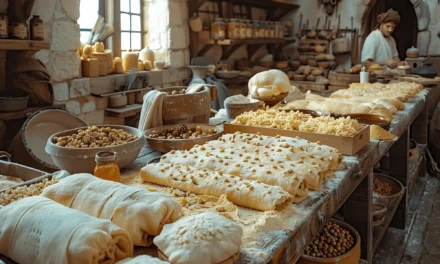Couscous is a delicious, nutritious, and versatile food that has been a staple in North African cuisine for centuries. It is made from durum wheat semolina and traditionally served with a stew.
Couscous is a great alternative to rice or pasta and is perfect for those on a gluten-free diet. It is low in fat and calories and a good protein and fiber source.
Couscous is quick and easy to prepare and can be flavored with a variety of spices and herbs. It can be served hot or cold and can be used in salads, soups, stews, or as a side dish.
If you haven’t tried couscous yet, what are you waiting for? It’s time to schedule a visit to a restaurant, and for today it is time to know about how the couscous came to be.
How Berber’s couscous Spread Across the Arab World
In Algeria, a country with a rich and varied history, a researcher has discovered evidence that suggests couscous may have been eaten there as early as 2000 years ago. Lucie Bolens, a historian, made the discovery while studying pottery and other artifacts from the period1.
Bolens found that some of the pots and utensils found in Algeria could have been used to make couscous. She also found evidence that the people of the time were familiar with the techniques needed to make the dish1.
This discovery is important because it shows that couscous is not just a dish from the Maghreb region but also has a long history in Algeria1.
Algeria was known as Numidia, which existed within the Berber kingdom. The Berbers, a group who lived in North Africa and the Sahara Desert, were the first people to discover a unique way of cooking with wheat1.
They would roll the wheat and moisten it into small spherical grains. Then, they would cook it to obtain a fluffy mass. This dish was called couscous. Couscous was an essential dish in the Berber diet. The Berbers would often eat couscous with meat and vegetables2.
Between 642 and 669 AD, Arabs started military expeditions in Berber territory, and most Berbers converted to Islam, starting a new age for couscous2.
In the early 7th century, Arab general Khalid ibn al-Walid and his troops set out on a series of military expeditions in Berber territory. These campaigns were relatively successful, and most Berbers converted to Islam. This new religion brought with it a new tradition of eating couscous2.
The conversion of the Berbers to Islam marked a significant turning point in the history of couscous. Prior to this, the dish was only eaten by a small minority of people. But now, it was being enjoyed by a much larger population2.
An Oasis for the Palate: How couscous conquered the Arab world
After the death of Muhammed, Muslims conquered the territories of North Africa. This expansion of the Islamic faith also led to the spread of new foods and recipes throughout the Arab world. One of these new dishes was couscous2.
Between the VIII to XI centuries, Arab travelers spread couscous through the Islamic world. Couscous quickly became a staple food in many Muslim households2.
In many places of the Islamic World, couscous played a crucial role in religious traditions. For example, in the Emirate of Nekor (today’s Morocco), eating couscous after Friday midday prayers became a tradition for Muslim pilgrims3.
Nekor, alongside Al-Andalus were emirates that belonged to the vast Umayyad Caliphate. Al-Andalus, in particular, became a veritable center of learning and culture, and couscous quickly became a staple dish in its kitchens2.
Indeed, the first written descriptions of couscous that we know about date back to the 11th century, when it was known as the “alcuzcuz fitīyānī” and was said to be enjoyed by the young, and described as “known all over the world.”2
Fast forward to the 13th century, and we find couscous mentioned in a poem dedicated to the Nasrid dynasty (1230-1492), which ruled over Al-Andalus for nearly two centuries until falling before the Catholic kings2.
Leo Africanus, one of the last Andalusian travelers to write about couscous, had this to say about the humble dish: “Of all things to be eaten once a day, it’s alcuzcuçu because it costs little and nourishes a lot.”2
Despite its Arab popularity, couscous was not just the preserve of the Arabs; it was also enjoyed by other peoples of the Islamic world, such as the nomadic Kel Ahaggar tribe of the Sahara Desert1.
COUSCOUS Conquest 2.0: This time, it’s here to stay!
It’s pretty funny how history repeats itself, don’t you think? Just 800 years ago, the Muslims had taken over the Iberian Peninsula. And now, in 1492, the Catholics had taken it back. Talk about a power struggle! Of course, the people who lived there had to go along with whichever side was in charge, so if they wanted to stay, they had to start following Catholic customs2.
Muslim communities during medieval Spain had quite a sophisticated cuisine. In an effort to, let’s say, “encourage” them to adopt Christian customs, Spanish authors snooped around and translated knowledge of Muslim cooking into Spanish2.
For example, they took note of couscous. Pedro de Alcala’s Vocabulista describes it as “hormigos de massa” (coarse-ground wheat dough)2.
Couscous could have easily disappeared when the Muslims were forced out of Spain. However, its significance ensured that it remained a part of this new society2.
How a Arab dish won the hearts of Europeans
Couscous has been a popular dish among Europeans for centuries, with some evidence of the fluffy dish being eaten as early as the seventeenth century. Although it’s possible that Europeans tried couscous earlier, it wasn’t until later on that the recipe became widely enjoyed 4.
Jean-Jacques Bouchard’s diaries provide an intimate look into the early days of couscous’ popularity in Europe, specifically in Toulon, France in 1630. He was one of the first to try the dish, and his detailed description helps us understand how the meal was prepared and enjoyed2.
In his words: “It’s a certain kind of pasta which is made of little grains like rice, and which puffs up considerably when cooked; it comes from the Levant and is called courcoussou.”2
On the other side of the British channel, later in 1699, Charles de Clurambault was wowed by a new dish he encountered while attending a Muslim diplomat reception. The meal was described as “a delicious dish Arabs cooked for Ramadan.” It turns out the Moroccan ambassador, Abd Allah bin Aisha, and his 18-person entourage had made couscoussou to show off to the guests3.
Thanks to early documentation by people like Jean-Jacques Bouchard and Charles de Clairambault, we know that couscous was a popular dish among both the French and the British during the XVII century2.
How Couscous Went From a Local Algerian Recipe to a Worldwide Dish
Couscous was a recipe made by hand for the most part. However, in 1853, the Ricci family, who were French-Italian colonists, developed a semi-industrial process for couscous in Algeria1.
This new process made it possible to mass produce couscous, making it more readily available to the general public5.
The Ricci family owned a pasta factory and operated it in the city of Blida, which is located 48 km southwest of Algiers1.
Their method still used to this day is steaming the semolina flour over boiling water until it forms into small balls5.
Although some processes became automated, others remained manual until complete automatization arrived one century later5.
That’s when the French mechanized all the processes from the semolina making until the packaging of the little balls in boxes as we know them today in the Western world4.
In 1962, France officially recognized Algeria as an independent state, ending the eight-year Algerian War of Independence. The devastating war had begun in 1954 when the National Liberation Front (FLN) launched a rebellion against French colonial rule1.
Throughout the conflict, hundreds of thousands of Algerians and thousands of French soldiers were killed. The war also profoundly impacted French society1.
Around a million Europeans settled in France after independence, bringing with them their love of couscous4.
These manufacturers were able to commercialize couscous in France, and Maghrebi restaurants owned by African immigrants promoted the recipe4.
The perfect comfort food for any season
Couscous is a staple food in many parts of the world, particularly in North Africa, the Middle East, and parts of Asia and Europe.
In France and Europe, couscous is often served as a main course, and it is a popular dish for both casual and formal occasions. The dish is usually made with lamb or chicken, but it can also be made with beef, fish, or vegetables. Couscous is typically served with a tomato-based sauce, but it can also be served with a variety of other sauces, including yogurt-based sauces, harissa, and mint sauces4.
Couscous is a versatile dish that can be adapted to a variety of different tastes and preferences. It is a healthy and nutritious food that is low in fat and calories. Couscous is an excellent source of fiber and protein and a good source of vitamins and minerals4.
Final thoughts
Couscous is a dish with a long and varied history. It is believed to have originated in Algeria and has been eaten there for centuries. Other peoples of the Arab world have also enjoyed the plate, including the nomadic Kel Ahaggar tribe of the Sahara Desert.
Couscous was first introduced to Europe in the seventeenth century and has been a popular dish among Europeans ever since.
Thanks to its worldwide popularity, it is a staple food in many parts of the world and shows no signs of slowing down.
Who would have thought that a humble dish like couscous would have such an illustrious history?
So next time you sit down to enjoy a steaming bowl of couscous, remember that you are part of a rich and diverse history that spans centuries and continents. Who knows, maybe one day your great-grandchildren will be telling their friends about the time they ate couscous just like you do today!
- Chemache, L., Kehal, F., Namoune, H., Makhlouf, C., & Gagaoua, M. (2018). Couscous: Ethnic making and consumption patterns in the Northeast of Algeria. Journal of Ethnic Foods, 211-219.[↩][↩][↩][↩][↩][↩][↩][↩][↩]
- Wright, C. A. (2017, June 29). History of Couscous. Retrieved from CliffordAWright.com: http://www.cliffordawright.com/caw/food/entries/display.php/id/34/[↩][↩][↩][↩][↩][↩][↩][↩][↩][↩][↩][↩][↩][↩][↩][↩][↩]
- Morocco World News. (2019, August 19). Friday Couscous: Morocco’s Most Valued Tradition. Morocco World News.[↩][↩]
- Durmelat, S. (2015). Tasting Displacement: Couscous and Culinary Citizenship in Maghrebi-French Diasporic Cinema. Food and Foodways: Explorations in the History and Culture of Human Nourishment, 104-126.[↩][↩][↩][↩][↩][↩]
- UNESCO. (2020, December 18). Knowledge, know-how and practices pertaining to the production and consumption of couscous. Retrieved from United Nations Educational, Scientific and Cultural Organization: https://ich.unesco.org/en/RL/knowledge-know-how-and-practices-pertaining-to-the-production-and-consumption-of-couscous-01602[↩][↩][↩]




